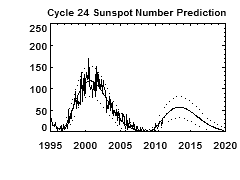    
Forummaster
Moderator
Username: Forummaster
Post Number: 545
Registered: 11-2001

| | Posted on Tuesday, March 08, 2011 - 7:03 pm: | 


|
Everyone has been wondering what happened to the skip that normally occurs as the sunspot cycle reaches its peak? You know those signals that can come from over a thousand miles away. If you have been using a radio for over 11 years then you have experienced the high and low cycle of skip.
It is well known that the sun goes through an eleven year cycle where at the height sunspots cause radio waves to bounce off the atmosphere and back down to earth, creating a skip effect. The height of solar activity was supposed to occur in 2011 and 2012. But for some unexplained reason the sun has stayed in it's slumber.

A team of scientists from Montana State University have solved the mystery and found a way to predict the next lapse in solar activity. The MSU scientists published a paper March 3rd explaining why sunspots were missing from 2008 to 2010. They found that the recent lull lasted twice as long as usual. The last time such a thing occurred was around 1913. Before that, it happened in 1810. These lulls were found to coincide with unusually weak magnetic fields at the sun's poles.
They identified that variations in a hot plasma flow in the sun's interior, known as the meridional circulation, as the likely reason behind the lack of sunspots and a weak magnetic field at the sun's poles.
Sunspots form when intense magnetism in a small area causes the plasma to cool off. The sunspots appear dark because they are cooler than the surrounding gases, usually about 2,700-4,200 degrees Celsius. The solar surface is about 5,700 degrees.
Plasma deep in the solar interior flows like a conveyor belt. When sunspots start to fade they are pulled under the surface by this conveyor belt action. When they reach about half way to the center the sun's rotation amplifies the sunspot's magnetic field and the sunspot rises to the surface. This process happens in a roughly 11 year cycle.
Since the past three occurences including this one happened around 100 years apart it's unlikely we will see another one anytime soon. Sunspot's are on the rise and even though conditions won't be as good as the last few cycles we will see an increase over the next few years.
Forummaster
CEF001
CVC001
|



